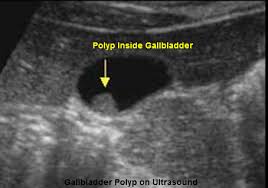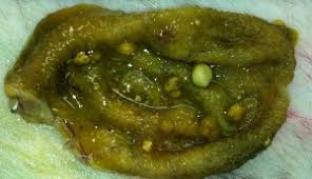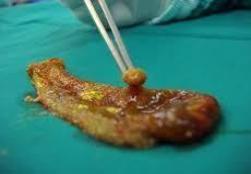| SINGLE HOLE SURGERY FOR GALL BLADDER STONE |
Gallbladder polyps are growths that protrude from the lining of the inside of the gallbladder. Polyps can be cancerous, but they rarely are.
About 95 percent of gallbladder polyps are benign.
The size of a gallbladder polyp can help predict whether it's cancerous (malignant) or noncancerous (benign). Small gallbladder polyps
that are less than 1/2 inch — about 10 millimeters (mm) — in diameter are unlikely to be cancerous and generally don't require
treatment.
However, for these polyps, your doctor may suggest follow-up examinations to look for changes that may be an indication of cancer.
This can be done using standard abdominal ultrasound or endoscopic ultrasound.
Gallbladder polyps larger than 1/2 inch (about 10 mm) in diameter are more likely to be cancerous or turn into cancer over time, and
those larger than 3/4 inch (18 mm) in diameter may pose a significant risk of being malignant. Treatment of larger gallbladder polyps
includes surgical removal of the gallbladder (cholecystectomy). Again, malignant polyps are extremely rare. Only about 5 percent of
gallbladder polyps are cancerous.
Your doctor may also recommend cholecystectomy if you have a gallbladder polyp of any size accompanied with gallstones.
https://www.mayoclinic.org/gallbladder-polyps/expert-answers/faq-20058450
About 95 percent of gallbladder polyps are benign.
The size of a gallbladder polyp can help predict whether it's cancerous (malignant) or noncancerous (benign). Small gallbladder polyps
that are less than 1/2 inch — about 10 millimeters (mm) — in diameter are unlikely to be cancerous and generally don't require
treatment.
However, for these polyps, your doctor may suggest follow-up examinations to look for changes that may be an indication of cancer.
This can be done using standard abdominal ultrasound or endoscopic ultrasound.
Gallbladder polyps larger than 1/2 inch (about 10 mm) in diameter are more likely to be cancerous or turn into cancer over time, and
those larger than 3/4 inch (18 mm) in diameter may pose a significant risk of being malignant. Treatment of larger gallbladder polyps
includes surgical removal of the gallbladder (cholecystectomy). Again, malignant polyps are extremely rare. Only about 5 percent of
gallbladder polyps are cancerous.
Your doctor may also recommend cholecystectomy if you have a gallbladder polyp of any size accompanied with gallstones.
https://www.mayoclinic.org/gallbladder-polyps/expert-answers/faq-20058450


